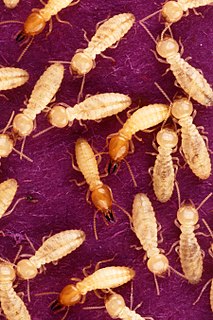
Termites are eusocial insects that are classified at the taxonomic rank of infraorder Isoptera, or as epifamily Termitoidae within the order Blattodea. Termites were once classified in a separate order from cockroaches, but recent phylogenetic studies indicate that they evolved from cockroaches, as they are the sister group to wood eating cockroaches of the genus Cryptocercus. Previous estimates suggested the divergence took place during the Jurassic or Triassic. More recent estimates suggest they have an origin during the Late Jurassic, with the first fossil records in the Early Cretaceous. About 3,106 species are currently described, with a few hundred more left to be described. Although these insects are often called "white ants", they are not ants, and are not closely related to ants.
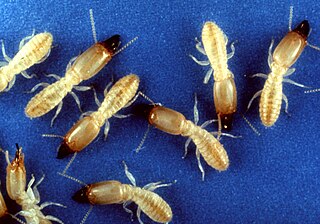
Reticulitermes flavipes, the eastern subterranean termite is the most common termite found in North America. These termites are the most economically important wood destroying insects in the United States and are classified as pests. They feed on cellulose material such as the structural wood in buildings, wooden fixtures, paper, books, and cotton. A mature colony can range from 20,000 workers to as high as 5 million workers and the primary queen of the colony lays 5,000 to 10,000 eggs per day to add to this total.

Mastotermes darwiniensis, common names giant northern termite and Darwin termite, is a termite species found only in northern Australia. It is the most primitive extant termite species.
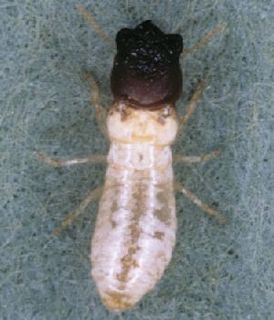
Kalotermitidae is a family of termites, commonly known as drywood termites. Kalotermitidae includes 21 genera and 419 species. The family has a cosmopolitan circumtropical distribution, and is found in functionally arid environments.

Zootermopsis angusticollis is a species of termite (Isoptera) in the family Archotermopsidae, a group known as the dampwood termites, or the rottenwood termites. As their name suggests, the dampwood termites can only survive by living off of wood that contains high amounts of moisture. They are found along the wet environments of the Pacific coast of North America. Most are found in the states of California, Oregon, Washington, Idaho, Western Nevada and in southern British Columbia. Termites are well known to be destroyers of wood, and although the dampwood termites can cause some damage, they are not as notoriously known to cause as much damage to buildings as the drywood termites. They occasionally have been carried to other parts of the country through wood shipments, but have not been able to become established in these areas due to undesirable environmental conditions.
Coptotermes gestroi, the Asian subterranean termite is a small species of termite that lives underground. Both this species and the Formosan subterranean termite, are destructive pests native to Asia, but have spread to other parts of the world including the United States. In Asia, this species is known as the Philippine milk termite.
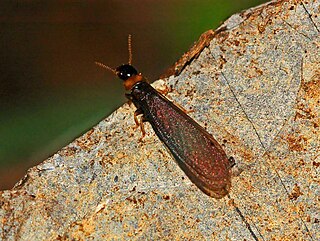
Kalotermes flavicollis, the yellownecked dry-wood termite, is a species of dampwood termites belonging to the family Kalotermitidae, one of the most primitive families of termites.

Mastotermes is a genus of termites. The sole living species is Mastotermes darwiniensis, found only in northern Australia. A number of extinct taxa are known from fossils. It is a very peculiar insect, the most primitive termite alive. As such, it shows notable similarities to certain cockroaches, the termites' closest relatives. These similarities include the anal lobe of the wing and the laying of eggs in bunches, rather than singly. The termites were traditionally placed in the Exopterygota, but such an indiscriminate treatment makes that group a paraphyletic grade of basal neopterans. Thus, the cockroaches, termites and their relatives are nowadays placed in a clade called Dictyoptera.

Reticulitermes is a termite genus in the family Rhinotermitidae. They are found in most temperate regions on Earth including much of Asia and the Middle East, Western Europe, and all of North America.

Incisitermes minor is a species of termite in the family Kalotermitidae known commonly as the western drywood termite. It is native to western North America, including the western United States and northern Mexico. It has been found in many other parts of the United States, all the way to the East Coast. It has been reported from Toronto. It has been introduced to Hawaii. It has been noted in China and it is not uncommon in Japan. This is an economically important pest of wooden structures, including houses. In California and Arizona alone its economic impact is estimated to be about $250 million per year.

Cryptotermes brevis is a species of termite in the family Kalotermitidae, commonly known as the West Indian drywood termite or the powderpost termite. It is able to live completely inside timber structures or articles made of wood such as furniture without any outside source of water. It is frequently introduced into new locations inadvertently, and causes damage to the structural timbers of buildings and to wooden objects such as furniture.
Postelectrotermes militaris is a species of drywood termite of the genus Postelectrotermes. It is native to India and Sri Lanka. It is a serious pest of tea.
The domestic drywood termite,, is a species of dry wood termite of the genus Cryptotermes. It is native to Malaysia, Borneo, Australia, China and Sri Lanka. It is mainly a house termite and also found in cultivated areas. The presence of this termite can be identified by small heaps of tiny egg-like pellets of excreta. It is a larger termite species, with 3.25-5.90mm in soldiers. It is considered as a minor pest in Australia, but is a serious pest causing wood damage in other parts of the world.
The West Indian drywood termite,, is a species of dry wood termite of the genus Cryptotermes. It is native to Indonesia, Java and exotic to Australia, Trinidad and Tobago and Sri Lanka. It is predominantly a house termite found in natural and man-made wooden structures. Thus, this is the most commonest and most devastating drywood pest termite found in the world. It is a larger termite species, with 4.55-7.15mm length in soldiers.
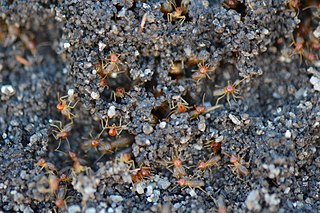
Amitermes hastatus, commonly known as the black mound termite, is a species of termite found in the Western Cape region of South Africa. It is endemic to the region's fynbos ecosystem. They build distinctive black termite mounds that range in height from a few centimeters to 50 centimeters. The species is commonly found on sandy soil eroded from white Table Mountain sandstone at altitudes from just under 100 meters up to 900 meters above sea level.
Zootermopsis laticeps, known generally as Arizona dampwood termite, is a species of termite in the family Archotermopsidae. Other common names include the wide-headed rottenwood termite and southwestern rottenwood termite. It is found in arid parts of southwestern North America.
Marginitermes is a genus of termites in the family Kalotermitidae. There are at least three described species in Marginitermes.
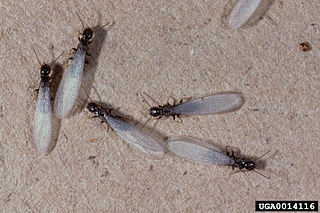
Reticulitermes virginicus is a species of subterranean termite native to North America, found often in the southern United States. It was described in 1907.
Amitermes floridensis, commonly known as the Florida darkwinged subterranean termite, is a species of eusocial insect in the family Termitidae. It feeds on rotting wood, reached by a network of tunnels. It is endemic to west central Florida and was first described in 1989.
Pterotermes is a monotypic genus of termites in the family Kalotermitidae. Pterotermes occidentis is the single species in the genus. This termite lives in the extremely dry conditions found in the Sonoran Desert in southwestern United States, Baja California and Mexico. It feeds on dry wood and lives entirely within a single piece of timber.









